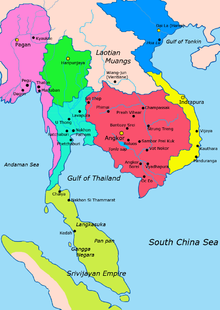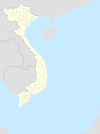Đại Việt-Khmer War
| Đại Việt-Khmer War | |||||||
|---|---|---|---|---|---|---|---|
| Part of Khmer–Cham wars | |||||||
 Map of Southeast Asia between the 1000–1100 | |||||||
| |||||||
| Belligerents | |||||||
| Đại Việt (Lý dynasty) |
| ||||||
| Commanders and leaders | |||||||
| |||||||
| Strength | |||||||
| 30,000 (1136)[1] |
| ||||||
The Đại Việt-Khmer War were a series of wars and conflicts fought between the Kingdom of Đại Việt and the combined forces of Champa and the Khmer Empire between 1123 and 1150.
Background[]
At this time, Đại Việt was in a vulnerable position due to internal conflict and a series of wars with their neighbors. In 1127, the 12-years-old Crown Prince Lý Dương Hoán became the new ruler of Đại Việt.[2] Suryavarman II demanded Đại Việt to pay tribute for the Khmer Empire, but the Vietnamese refused to pay tribute to the Khmers. Suryavarman II decided to expand his territory northward into Vietnamese territory.[1]
The conflicts[]

The first attack was in 1128 when King Suryavarman II led 20,000 soldiers from Savannakhet to Nghệ An but were routed in battle. The following year Suryavarman continued skirmishes on land and sent 700 ships to bombard the coastal areas of Đại Việt. The warfare escalated in 1132 when Khmer Empire and Champa jointly invaded Đại Việt, briefly seizing Nghệ An. During that time, the minister Lê Bá Ngọc and his adopted son Đỗ Anh Vũ dominated the Viet court. In 1136, Đỗ Anh Vũ led an expedition with thirty thousand troops into Khmer territories, but his army later retreated after subdued highland tribes in Xiangkhoang.[1] By 1136, King Jaya Indravarman III of Champa made peace with the Vietnamese, which led to the Khmer–Cham War. In 1138, Lý Thần Tông died aged 22 from a disease and was succeeded by his two years old son Lý Anh Tông. Suryavarman II led several more attacks on Đại Việt until his death in 1150.[3]
Aftermath[]
After a failed attempt to seize seaports in southern Đại Việt, Suryavarman turned to invade Champa in 1145 and sacked Vijaya, ending the reign of Jaya Indravarman III and destroying the temples at Mỹ Sơn .[4][5] Inscriptional evidence suggests that Suryavarman II died between 1145 AD and 1150 AD, possibly during a military campaign against Champa. He was succeeded by Dharanindravarman II, a cousin, son of the brother of the king's mother. A period of weak rule and feuding began.
In Đại Việt, the victories famed Đỗ Anh Vũ and weakened the royal throne. He became regent of the court of Đại Việt until his death in 1159.[6]
References[]
- ^ a b c Kiernan 2017, pp. 162–163.
- ^ Kiernan 2017, pp. 161.
- ^ Kohn 2013, pp. 524.
- ^ Coèdes (1968). The Indianized States of Southeast Asia. p. 160.
- ^ Maspero (2002). The Champa Kingdom. pp. 75–76.
- ^ Kiernan 2017, pp. 164.
Sources[]
- Kiernan, Ben (2017), Việt Nam: A History from Earliest Times to the Present, Oxford University Press, ISBN 978-0-19-516076-5.
- Kohn, George Childs (2013), Dictionary of Wars, Routledge, ISBN 978-1-13-595494-9.
- Coèdes, George (1968). Vella, Walter F. (ed.). The Indianized States of Southeast Asia. trans.Susan Brown Cowing. University of Hawaii Press, ISBN 978-0-8248-0368-1.
- Maspero, Georges (2002). The Champa Kingdom. ISBN 9789747534993.
- History of Cambodia
- History of Vietnam
- 12th-century conflicts
- Geopolitical rivalry
- Military history of Cambodia
- Wars involving Cambodia
- Military history of Vietnam
- Wars involving Vietnam
- Military history stubs


